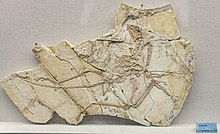
Back طيريات الأجنحة Arabic طيريات الاجنحه ARZ Авиали Bulgarian Avialats Catalan Avialae Czech Avialae German Avialae Spanish پرندهبالان Persian Avialae Finnish Avialae French
| Avialans | |||
|---|---|---|---|

| |||
| Fossil specimen of Jeholornis prima | |||

| |||
| Collage of four extant birds. Clockwise from top-left: Spanish imperial eagle (Aquila adalberti), common ostrich (Struthio camelus), mallard (Anas platyrhynchos), and common kingfisher (Alcedo atthis) | |||
| Scientific classification | |||
| Domain: | Eukaryota | ||
| Kingdom: | Animalia | ||
| Phylum: | Chordata | ||
| Clade: | Dinosauria | ||
| Clade: | Saurischia | ||
| Clade: | Theropoda | ||
| Clade: | Pennaraptora | ||
| Clade: | Paraves | ||
| Clade: | Avialae Gauthier, 1986 | ||
| Subgroups | |||
| |||
Avialae ("bird wings") is a clade containing the only living dinosaurs, the birds, and their closest relatives. It is usually defined as all theropod dinosaurs more closely related to birds (Aves) than to deinonychosaurs, though alternative definitions are occasionally used (see below).
Archaeopteryx lithographica, from the late Jurassic Period Solnhofen Formation of Germany, is usually considered the earliest known avialan which may have had the capability of powered flight;[3] a minority of studies have suggested that it might have been a deinonychosaur instead.[4] Several older (but non flight-capable) possible avialans are known from the late Jurassic Tiaojishan Formation of China, dated to about 160 million years ago.[5][6]
- ^ Schweigert, G. (2007). "Ammonite biostratigraphy as a tool for dating Upper Jurassic lithographic limestones from South Germany – first results and open questions" (PDF). Neues Jahrbuch für Geologie und Paläontologie - Abhandlungen. 245 (1): 117–125. doi:10.1127/0077-7749/2007/0245-0117. S2CID 140597349.
- ^ Zhang, H.; Wang, M.; Liu, X. (2008). "Constraints on the upper boundary age of the Tiaojishan Formation volcanic rocks in West Liaoning-North Hebei by LA-ICP-MS dating". Chinese Science Bulletin. 53 (22): 3574–3584. Bibcode:2008SciBu..53.3574Z. doi:10.1007/s11434-008-0287-4.
- ^ Alonso, P. D.; Milner, A. C.; Ketcham, R. A.; Cookson, M. J.; Rowe, T. B. (2004). "The avian nature of the brain and inner ear of Archaeopteryx" (PDF). Nature. 430 (7000): 666–669. Bibcode:2004Natur.430..666A. doi:10.1038/nature02706. PMID 15295597. S2CID 4391019. Archived from the original (PDF) on 2006-02-09. Supplementary info
- ^ Hartman, Scott; Mortimer, Mickey; Wahl, William R.; Lomax, Dean R.; Lippincott, Jessica; Lovelace, David M. (2019-07-10). "A new paravian dinosaur from the Late Jurassic of North America supports a late acquisition of avian flight". PeerJ. 7: e7247. doi:10.7717/peerj.7247. ISSN 2167-8359. PMC 6626525. PMID 31333906.
- ^ Hu, D.; Hou, L.; Zhang, L. & Xu, X. (2009). "A pre-Archaeopteryx troodontid theropod from China with long feathers on the metatarsus". Nature. 461 (7264): 640–643. Bibcode:2009Natur.461..640H. doi:10.1038/nature08322. PMID 19794491. S2CID 205218015.
- ^ Liu Y.-Q.; Kuang H.-W.; Jiang X.-J.; Peng N.; Xu H.; Sun H.-Y. (2012). "Timing of the earliest known feathered dinosaurs and transitional pterosaurs older than the Jehol Biota". Palaeogeography, Palaeoclimatology, Palaeoecology. 323–325: 1–12. Bibcode:2012PPP...323....1L. doi:10.1016/j.palaeo.2012.01.017.